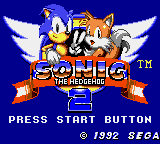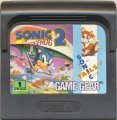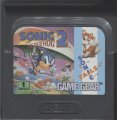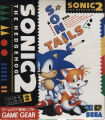Difference between revisions of "Sonic the Hedgehog 2 (8-bit)"
From Sonic Retro
(→Manuals) |
|||
| Line 46: | Line 46: | ||
* [[Sonic the Hedgehog 2 (Game Gear) US Manual]] | * [[Sonic the Hedgehog 2 (Game Gear) US Manual]] | ||
* [[Sonic the Hedgehog 2 (Game Gear) EU Manual]] | * [[Sonic the Hedgehog 2 (Game Gear) EU Manual]] | ||
| − | * [[Sonic the Hedgehog 2 (Game Gear) JP Manual]] | + | * [[Sonic the Hedgehog 2 (Game Gear) JP Manual]] (no manual scan) |
* [[Sonic the Hedgehog 2 (Master System) EU Manual]] | * [[Sonic the Hedgehog 2 (Master System) EU Manual]] | ||
Revision as of 13:29, 22 August 2008
| Sonic the Hedgehog 2 |
|---|
| System(s): Sega Game Gear & Master System |
| Publisher: Sega |
| Developer: Aspect Co. Ltd |
| Genre: 2D Platform |
Sonic the Hedgehog 2 was made in Japan by Aspect Co. Ltd for the Sega Master System, and later 'ported' to the Sega Game Gear. The Game Gear version contains noticable differences from the Master System version. (i.e., the boss music is different, some boss areas are different in layout) It was released simutaneously with Sonic the Hedgehog 2 on Genesis. Even though it shares the same name as the 16-bit game it is not a port as it contains entirely different levels. It was the first appearance of both Tails and Mecha Sonic (called Silver Sonic in the US manual) on Game Gear.
This is widely known as one of the hardest Sonic games ever made. This is partially due to the vertical scrolling this game uses. Often a player would take cheap hits due to not being able to see the obsticles and enemies around them. This problem was even worse in the Game Gear version because of the smaller screen width.
Strangely, Tails appears in every title card and has an almost complete sprite sheet, but is only seen in the opening and ending cutscenes. It is possible he was originally intended as a playable character, but cut for time issues, or because the level design was too simple for a flying character.
Contents
Gameplay
This game improved upon it's 8-bit predesessor in many ways. This includes the ability to grab back rings scattered when hit by an enemy, as well as being able to smash through certain walls.
Oddly enough, no Spin Dash was implemented, though this may be because this game was released before the Genesis version, which introduced the Spin Dash. Uniquely, this game includes levels in which Sonic must ride a mine cart and a hang glider. There is also a large bubble in underwater levels which raises Sonic upwards until he hits a ceiling, enemy or obstacle. Sonic is also able to skim across the surface of water if he picks up enough speed.
There are seven zones in total, each comprising three acts. In the final act, that level's boss is faced, but without any rings to collect. Rather than facing Robotnik himself, Sonic will most often face up against a bunch of robotic animals, such as a sumo pig and a circus sea-lion.
End Level Panel
At the end of Acts 1 and 2 of each level, a panel is spun, with a reward given based on what it lands on:
- Robotnik: No prize. This panel comes up most often in the game.
- Ring: 10 rings added to final ring tally. Usually obtained by having a ring count that is a multiple of ten.
- Sonic: Extra Life
- Tails: Continue
Items
Item boxes are largely the same as the first game (although the restart marker and shield devices have been removed). Chaos Emeralds are scattered throughout the stages. Each is found in the second act in each of the first five zones. If the player collects these and then destroys Mecha Sonic (called "Silver Sonic" in the English manual) in the sixth zone, they will obtain the sixth Emerald and can access the true final stage (Crystal Egg). This is required to obtain the Good Ending. If all the Emeralds are not colected then the game will end after Mecha Sonic's destruction.
Many levels also contain a unique obstacle, such as the minecarts in Underground Zone, the hang gliders in Sky High Zone, and the giant air bubbles in Aqua Lake Zone.
Storyline
Tails has been captured by Robotnik on South Island, and you must play as Sonic to retrieve not only the six chaos emeralds but Tails as well.
Differences between the Master System and Game Gear versions
The lower resolution is the first difference between the Game Gear and Master System versions. The Scrambled Egg music plays in the prelude cutscene, and the title screen has the music that was played in the prelude in the Master System version. Different music is used for the boss battles on each game. The Underground Zone Boss is more difficult due to the lowered resolution - you cannot see the bouncing balls coming from as far off, and the speed and bounce height of the balls is randomized in the Game Gear version. The color of the water in the Aqua Lake Zone Round 2 is now a dark blue instead of green, the speed shoes are also omited from this level. The Green Hills boss battle takes place on a steeper hill, and the escape chute cannot be seen while fighting Eggman in the final zone. The ending music is different as the Master System game uses a sad sounding song in both endings, but the Game Gear version uses more upbeat music for the good ending. Strangely, the Master system actually has the upbeat music in the game but never uses it.
Manuals
- Sonic the Hedgehog 2 (Game Gear) US Manual
- Sonic the Hedgehog 2 (Game Gear) EU Manual
- Sonic the Hedgehog 2 (Game Gear) JP Manual (no manual scan)
- Sonic the Hedgehog 2 (Master System) EU Manual
Also Released On
- Sonic 2 in 1 for the Game Gear (1995)
- Sonic Mega Collection for the Nintendo Gamecube (2002)
- Sonic Adventure DX: Director's Cut for the Nintendo Gamecube (2003)
- Sonic Gems Collection for the Nintendo GameCube and Sony Playstation 2 (2005)
Production Credits
Composers: Tomozou, Simachan, Ray
Programmers: Ko,Ko, Semimaru, Tea Tea, Tosiyan
Art: Jly King, Noborin, Tez, U,D,K
Editing: Raizou, M,Shima, End, Mariyuri
Sound: Gatao, Nao Chan, Dawasa
Thanks: Asohy, Taku,S, The Hase, Thomas Y, Okusan, Lunarian, Hitmen, Aspect All Staff, You Nishiyama
Resources
Scans
Game Gear version
- Sonic2 gg kr cart.jpg
Korean cart
Master System version
Artwork
| Sonic the Hedgehog games for the following systems | |
|---|---|
| 1991 Sonic the Hedgehog 1992 Sonic the Hedgehog 2 1993 Sonic Chaos | Dr. Robotnik's Mean Bean Machine 1994 Sonic Drift | Sonic Spinball | Sonic the Hedgehog Triple Trouble 1995 Sonic Drift 2 | Tails' Skypatrol | Tails Adventures | Sonic Labyrinth | Sonic 2 in 1 1996 Sonic Blast Prototypes Sonic the Hedgehog (Game Gear prototype) | Sonic Chaos prereleases | Sonic Spinball (8-bit) prereleases | Sonic Triple Trouble prereleases | Sonic Blast prereleases Unreleased Sonic's Edusoft
| |

















